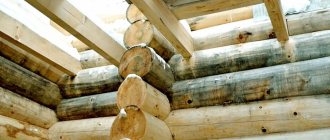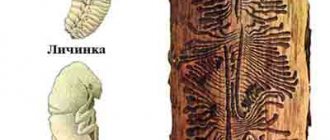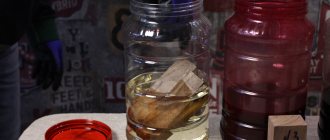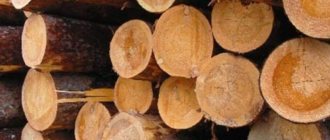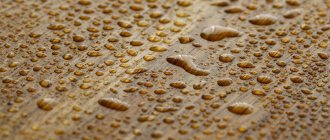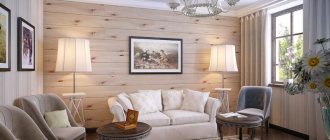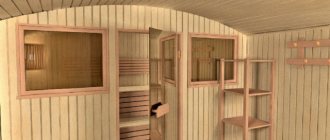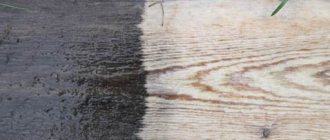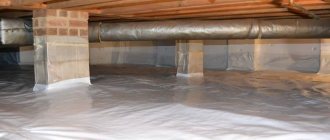Wood rot is areas of wood that are unusual and abnormal in color, texture and hardness, formed under the influence of wood-destroying fungi. They differ mainly in color. They often have a specific smell and wood structure that differs from healthy wood.
The best way to combat rot on wood is microwave treatment. Regular and proper drying - 100% protection of wood from rot and mold.
Below we will analyze the types and types of wood rot (+ show photos) and tell you how to distinguish them.
Causes of putrefactive processes, their types and stages
Biological destruction of wood is triggered in the following circumstances:
Wood rot often occurs due to dampness.
- damp and warm climate; availability of oxygen; internal humidity of the wood itself is above 18-20%.
These factors provide the opportunity for various fungi to parasitize wood and cause putrefactive processes. Thus, freshly cut logs in felling areas and piles of lumber in warehouses can be affected by the warehouse and pole fungus. And building materials and wooden structures made of both deciduous and coniferous wood can suffer due to the wood-destroying effects of many varieties of house mushrooms (real, white, membranous, etc.).
The type of decay depends on the tree’s own physical qualities and the type of fungus parasitizing on it.
For the destructive type, provoked by the larch sponge, sulfur-yellow, bordered and other tinder fungi:
When wood rots, cracks appear.
- The wood becomes smaller in volume. Cracks appear. The color of the wood changes from reddish to brown and dark brown. The structure of the wood becomes fragile. The wood disintegrates into pieces in the form of cubes and prisms, and then it crumbles into powder.
For corrosive putrefactive damage:
- The wood does not lose viscosity and volume. The destruction is partial and alternates with healthy zones. Cells and pits first appear in the wood material, then it begins to separate into fibrous layers. The color of wood affected by fungi becomes variegated (white spots on a brown base) or very light (white , light yellow or marbled).
The cause of variegated rot is fungi such as sponges (pine, root, spruce) and tinder fungi (oak, spruce butt). The white color is caused by honey fungus and tinder fungus (flat, false, true).
Core rot
CORE ROT - rot that occurs in the core of a growing tree, characterized by reduced hardness.
It is observed at the ends, in the form of spots of various sizes and shapes - holes, rings or a concentrated zone of continuous damage to the central part of the trunk, sometimes with access to the sapwood, on longitudinal sections - in the form of elongated spots and stripes.
Stages of the destruction process
Destruction of wooden poles in different conditions: a – in sandy soil, b – in dense clay soil; c - pile in a pond.
To assess whether it is possible to use the affected wood for technical purposes, it is necessary to determine at what stage of decay it is. The process of wood rotting goes through 4 stages:
Initial.
Mushroom mycelium does not affect the tree shell. The wood still retains its structure and strength, but only changes color to olive, lilac-gray or red-brown. Developed. Mother-in-law or pits appear in the wood.
Light stripes, films of mycelium, appear on a brown background. Final. The tree completely loses its strength, crumbles or splits into chips. The color fully corresponds to the type of decay. Mechanical destruction of wood, hollow formation.
When working with wood, you should always take into account the tendency of this building material to be affected by fungus and, depending on the desired result, prevent decay or accelerate decay.
How to deal with wood rotting?
It is necessary to prevent the development of fungi and the penetration of fungal spores into the core of the tree during the production and storage of the material. After all, after cutting, its humidity is close to 40%. To prevent putrefactive processes, protective measures such as natural and industrial drying of lumber are used.
When drying naturally, harvested lumber must rest for at least 1 year. During industrial drying, this process is significantly accelerated due to the method of heating lumber to 80-100 degrees. This is how the building material is sterilized, ridding it of mycelium and spores.
To prevent the wood from rotting, it must be treated with special compounds.
Treating wood with various water-soluble and oily antiseptics also helps stop rotting. In domestic conditions, surface antiseptic protection of wood is carried out. By going several times with a brush or spray to apply antiseptic, you can reliably saturate the top layer of wood.
Deep impregnation requires industrial capacity, since it is carried out by immersing wood elements for several hours in hot-cold antiseptic baths or using an autoclave. However, even very high-quality dry material can be subject to putrefactive contamination during its operation.
Spreading
Wood-decaying fungi mainly reproduce by spores, which are produced in large quantities in fruiting bodies. Spores are spread through the air, rain, insects and other means. They penetrate into tree tissue through damage to trunks, branches and roots - peeling, nicks, nicks, scuffs, cancerous wounds, as well as through saw cuts or broken branches. In these places of primary infection, the fruiting bodies of pathogens are subsequently formed. The high ability of xylotrophs to form spores is very dangerous for plantings.
In addition to spores, the infection can spread in the form of mycelium and its modifications, including mycelial films and rhizomorphs. The latter are dark brown, almost black, cord-like, branching plexuses of mycelium. Characteristic films and rhizomorphs are formed in the autumn honey fungus.
The development of rot in the affected organs occurs only if the wood substrate meets the requirements of the pathogen for humidity, temperature, mineral nutrition, and acidity of the environment.
Protection against the development of putrefactive processes in wooden structures
To ensure that a wooden log house, a log house, a bathhouse or other outbuildings made from this building material are not subject to rotting, you must adhere to all the rules for protecting the structure. Measures to prevent wood contamination by fungi and mold are:
Proper foundation waterproofing will protect the house from rotting.
- Arrangement of waterproofing of the foundation, drainage system for drainage of ground and surface water. Coating of wood with paints and varnishes. Presence of a moisture-proof roof of the building. Creation of ventilation of premises using vents. Correct installation of insulating layers on the walls of structures in order to prevent the accumulation of condensate (vapor barrier - indoors, and a thermal insulation membrane - outside).Protection of the ends of the logs by especially careful treatment with antiseptics or additional covering with boards.
In the case when a wooden structure is subjected to periodic moisture, only strong antiseptic agents stop rotting (for example, double-action chemicals “Neomid 400”, “Neomid 500”, which protect against moisture and rot). In this case, already rotten wood is completely cut down, removed from the premises and burned to avoid further contamination of the tree.
For preventive purposes, wooden buildings should be carefully inspected annually for damage by parasitic fungi. If lesions are detected, either the wooden element is completely replaced, or the infected area is cut down and subsequent antiseptic treatment is carried out.
How to speed up the process of wood decay
Sometimes the susceptibility of wood to rot can be regarded as a positive thing. If you know how to accelerate decay, you can use this feature of natural material to your advantage and force the fall of a tree or the removal of a stump.
Tips to speed up decay to remove dead trees and stumps are:
Drill more holes in them a couple of centimeters deep.
Insects will gather in these crevices, and moisture will accumulate during rainfall. Thus, the decay of cellulose will accelerate, and the wood will disintegrate much faster. You can speed up the decay if you sprinkle spores or pieces of fungi taken from already rotten wood of the same type onto a tree or stump. Water the ground around the unnecessary trunk with nitrogenous fertilizers, which will provoke the development of fungi -parasites. After some time, you can feed the fungi with sweet water to stimulate the growth of their population.
All of these tips can be used at the same time. And, of course, you should water the trees more often and moisten the stumps. Then favorable results will not take too long to arrive.
The main enemy of wood, a building material of organic origin, can certainly be called mushrooms and fungal spores, which penetrate deeply into the wood tissue, causing it to rot, quickly destroying the nutrients contained in it and transforming in a matter of months, the structure of a wooden house, bathhouse, or log house. , into a building crumbling before our eyes.
Photo: such wood, infected with rot fungus, very often arrives at sawmills.
Photo: if you take a closer look at such a forest, it becomes clear how badly the wood is affected by pests.
For fungal and mold spores to arise on the surface of wood, appropriate conditions are required. These conditions include wood humidity of 20-25%, positive air temperature from 0 to +35 degrees and exposure to moisture on wood.
These two potent remedies can stop the wood rotting that has begun. It is necessary to use a certain technology against the development of rotting of the wood of a wooden house, log house or bathhouse, since if the process of wood rotting is already in full swing, then it can only be stopped with potent complex agents such as Neomid 500 and Neomid 430. In good terms, protection against possible wood rotting it is necessary to begin at the stage of production and storage of lumber. If such protection has not been carried out and the logs or beams have not been treated with antiseptics, it is imperative to protect them from moisture using a moisture-proof roof, water-repellent compounds, in the form of varnishes, paints, or glazing compounds. Properly made waterproofing protects against condensation on the surface of wood.
Usually it is performed according to the principle of placing the first layer closer to the outside, where the surface is exposed to low temperatures, and the second, closer to the inside, where the warm surface is indoors. The first crowns of the building, located above ground level and separated from the concrete foundation, by various gaskets in the form of roofing material, bitumen mastic, or ordinary cellophane film folded in six layers will be protected from moisture, and therefore the formation of rot, for decades. If you treat them after installation with Neomid products, which have double action and protect against moisture, you don’t have to worry about rot. Photo - these are the most effective anti-wood products today, according to reviews from many construction experts. To promptly detect wood rot and prevent it further distribution, it is necessary to carry out a thorough inspection of the surfaces of the entire wooden building every year. Signs of rotting wood are a characteristic smell of rot and a white, thin film in places infected with spores of rot and mold. Depending on the size and extent of the affected areas, it is necessary to completely replace wooden structures affected by rot, or to treat them with bleaching compounds, with further processing antiseptic agents. The highest quality antiseptic compositions are Neomid products. Complex timely treatment with these antiseptics and bleaching will help protect the wood surface from rot and avoid dismantling a house made of timber or logs to replace rotten wooden structures of the building. Photo: the most popular means of protection against wood rotting – Neomid brand impregnations.
Measures to protect wood from rot
Above were six main reasons why dampness may occur in a wooden house, but dampness is not rot. Rot is a deeper form of dampness. The stage of its development is the following. First, dampness itself appears through exposure to moisture. Microbes and fungi fly everywhere, “watching” convenient places for future colonies. If a damp place is discovered, the fungus begins to multiply, large colonies of fungi appear, which develop an environment around them that is dangerous for the wood. The release of liquid and erosion of wood increases. Eventually, the wood begins to rot.
The initial process of decay can be stopped with antiseptics, but the advanced option is only by cutting out the affected area and burning it in a fire. Therefore, do not allow the initial form of rot - dampness - to develop, do not allow fungal colonies to develop - kill them with an antiseptic. Do not allow affected wood to transmit rot disease to healthy wood by cutting and burning it.
